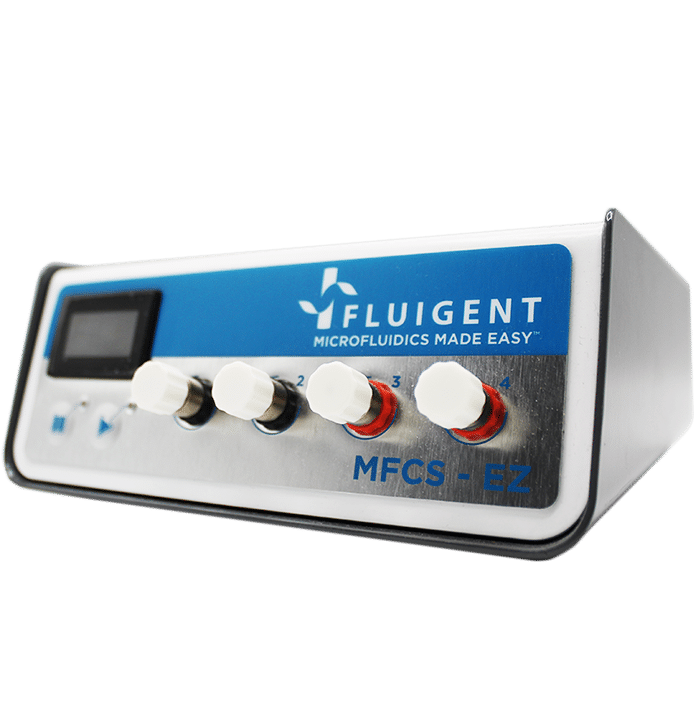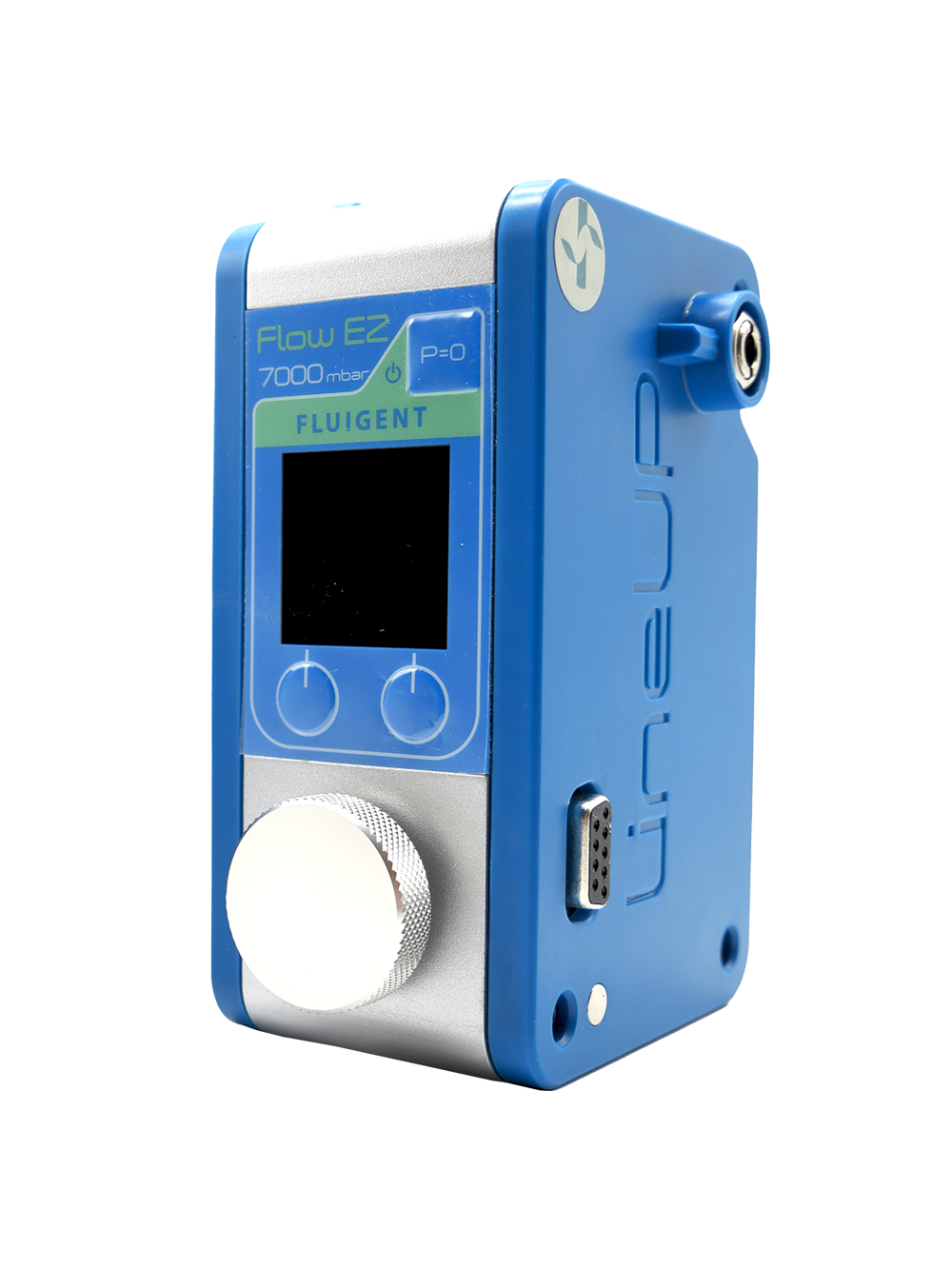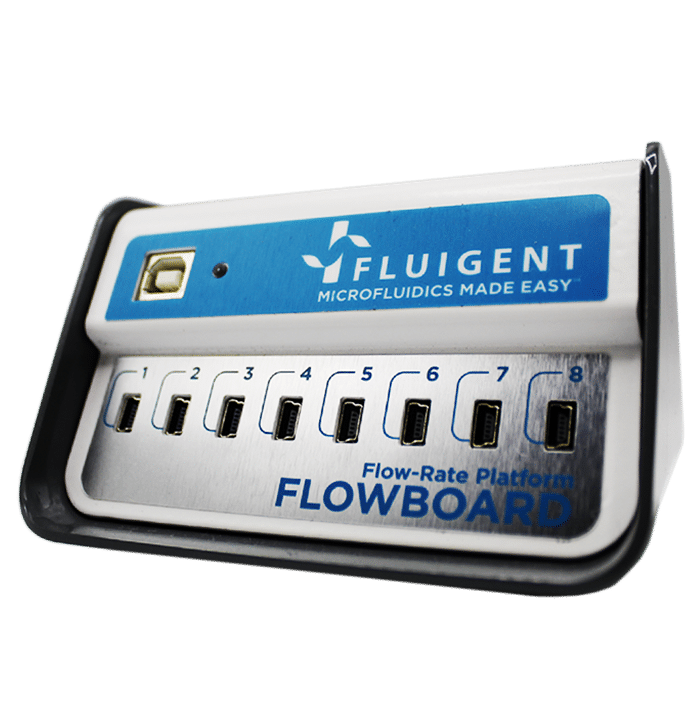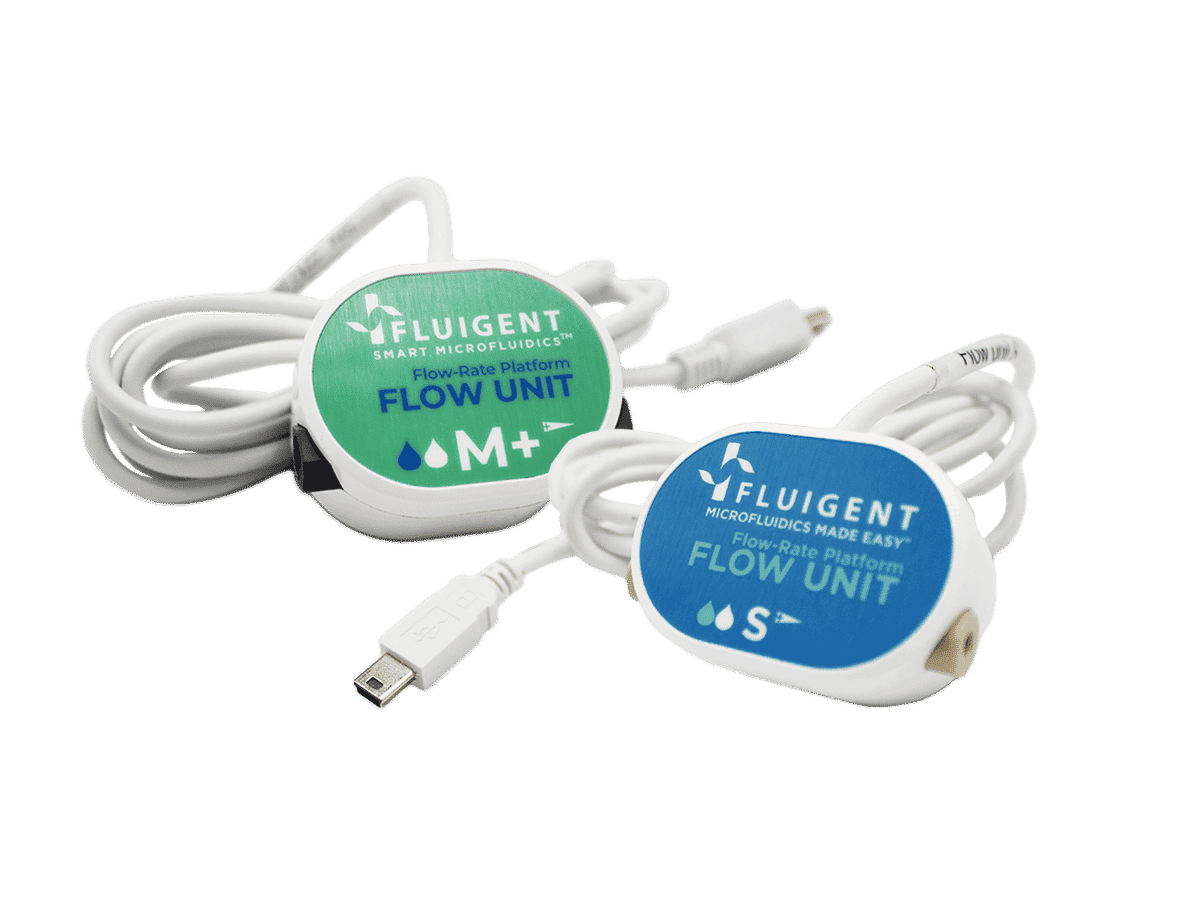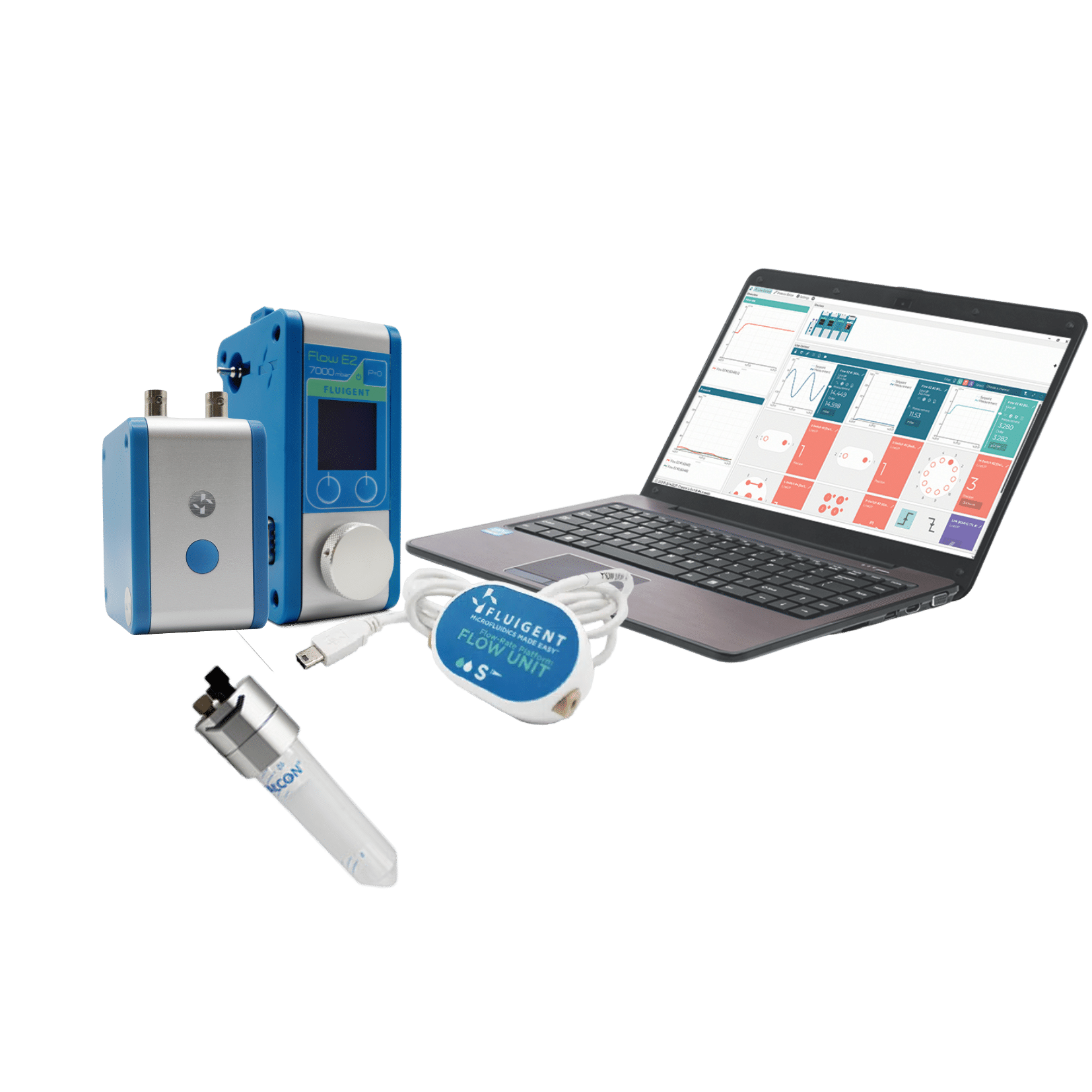Pressure-driven flow controllers vs. Syringe pumps: A flow precision evaluation for optical blood imaging.
A Functional Optical Imaging Laboratory Paper
The Functional Optical Imaging Laboratory (FOIL), led by Prof. Andrew Dunn, is affiliated with the Institute for Neuroscience at the University of Texas at Austin.
Their research activities are focused on developing novel optical imaging technologies and models for studying the brain such as Speckle Imaging and Multiphoton microscopy. In their recent paper in the Journal of Biomedical Optics, Colin Sullender et al. compared the efficiency of pressure-driven flow controllers to syringe pumps in terms of flow-related errors and their impact on optical flow imaging.
Find more about their work and team.
Sullender, Colin T., Adam Santorelli, Lisa M. Richards, Pawan K. Mannava, Christopher Smith, et Andrew K. Dunn.
« Using Pressure-Driven Flow Systems to Evaluate Laser Speckle Contrast Imaging ». Journal of Biomedical Optics 28, no 03 (11 mars 2023). https://doi.org/10.1117/1.JBO.28.3.036003
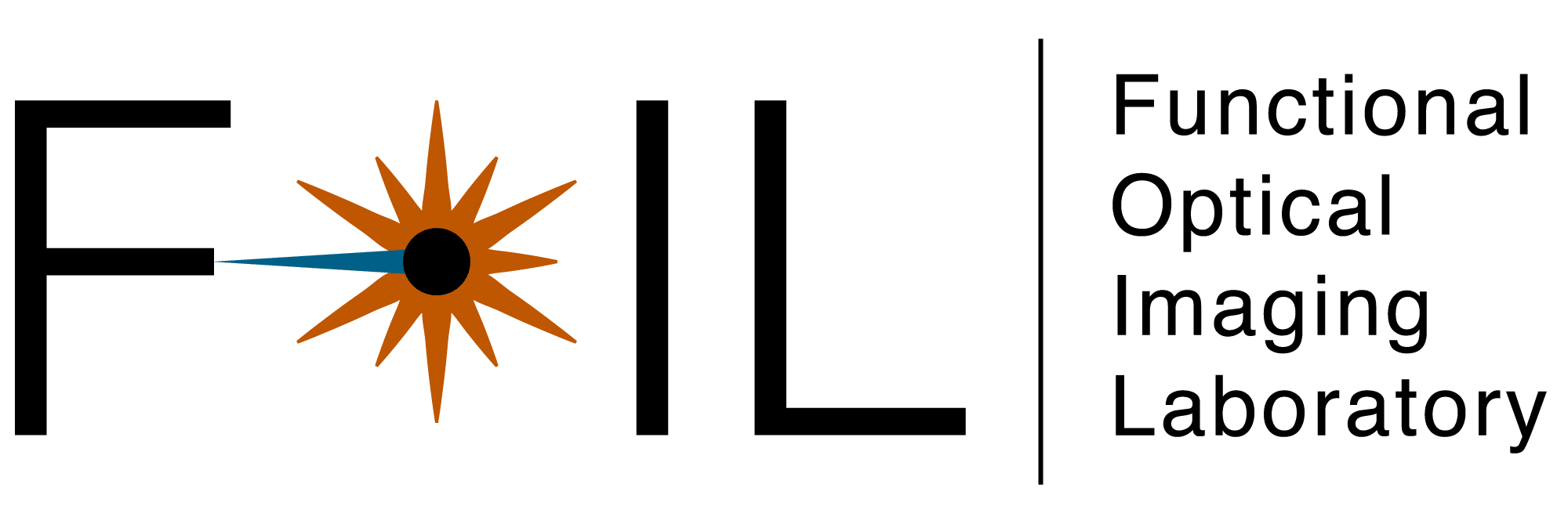
What is a pressure-driven flow controller
A microfluidic pressure-driven flow controller is used for the manipulation and regulation of fluid flow within microchannels or microfluidic devices using pressure differentials. Microfluidics is a field of science and technology that deals with the behavior, manipulation, and control of small volumes of fluids, typically on the microliter (10-6 liters) to nanoliter (10-9 liters) scale, within microscale channels or devices.
In microfluidic systems, precise control over fluid flow is crucial for various applications, including lab-on-a-chip devices, biomedical diagnostics, drug delivery systems, chemical analysis, and more. Pressure-driven flow control is one of the fundamental methods for achieving this control.
Overall, microfluidic pressure flow controller plays a crucial role in the miniaturization and automation of lab processes. It helps by using less samples and reagents, analyzing faster, and improved experimental control.
What makes pressure driven flow systems different than syringe pumps
To flow liquids with syringe pumps, a mechanical force is applied to the plunger of the syringe at a regulated speed, which is controlled by a rotating lead screw and a stepper motor. This system produces oscillations in flow with varying frequency and magnitude due to imperfections of the lead screw and motor, which therefore affect the flow stability. In addition, syringe pumps present a slow responsivity and can take a long time to achieve programmed flow rates.Within a pressure-driven flow controller, regulated gas pushes liquids from a reservoir through the microfluidic device at a constant flow rate. This operation eliminates the use of a lead screw and thus providing a stable flow and fast response.
Why flow precision is a key parameter for research applications
The lack of high responsivity and stability when using syringe pumps generates uncertainty and flow noises while conducting experiments. These flow-related errors impact the reliability of the measuring or imaging technique used in the study.
Laser Speckle Contrast Imaging (LSCI), for example, is an optical imaging method that is commonly used to visualize changes in blood flow. However, in order to obtain accurate results, it is crucial to thoroughly evaluate the performance of this technique beforehand.1 This evaluation is typically carried out by studying the flow of substances within a microfluidic device. Despite the need for high precision, repeatability, and stability in the flow during tests, a survey of more than 20 LSCI studies conducted since 2015 revealed that syringe pumps were used in most experiments (90%).2
The fluctuation in the flow produced by the syringe pumps can be incorrectly interpreted as flow changes induced by the studied experimental conditions. This also affects the reproducibility and efficiency of the imaging system towards its applications. In this perspective, Sullender et al. quantified in this paper the uncertainty for a syringe pump and our pressure driven flow controller (Fluigent MFCS-EZ) for LSCI.2

Flow comparison between syringe pumps and pressure-based flow controllers
To evaluate the efficiency of the pressure-driven controller, the MFCS-EZ was used to pressurize a microfluidic reservoir (Fluiwell-1C) filled with a blood-mimicking solution. A flow sensor (Flow Unit – Range L) was installed between the reservoir and the LCSI monitoring microfluidic chip. The pressure-driven controller was automatically regulated through MAESFLO control software (latest version: OxyGEN) based on the flow sensor’s feedback.
Two flow profiles were predefined to assess the flow repeatability and flow reproducibility of the system. By applying them, the blood-mimicking solution circulates from the microfluidic reservoir through the flow unit, in which the flow rate can be measured, to the microfluidic chip coupled to LSCI, in which the relative flow can also be detected.
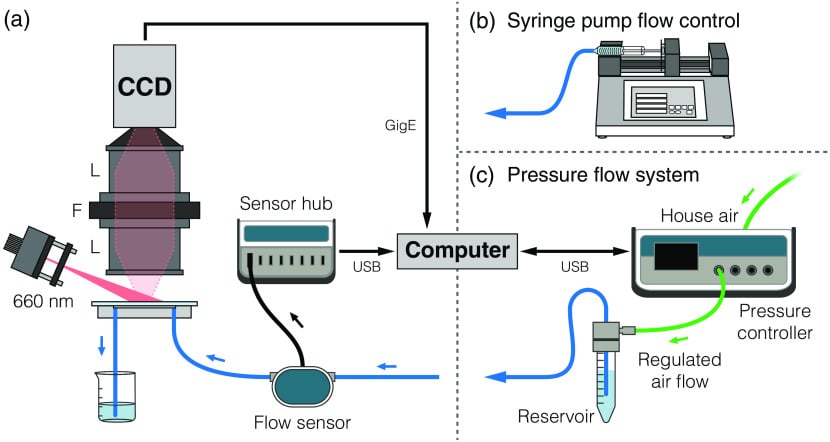
Similarly, a syringe pump system was connected to the flow sensor instead of the MFCS-EZ and the microfluidic reservoir. A 10-mL plastic syringe was filled with a blood-mimicking solution. The syringe pump was programmed to run the same predefined flow profiles.
Based on the flow measurement and profile, the repeatability and reproducibility were evaluated in the pressure-driven control system and the syringe pump by calculating their expanded uncertainty ratio.
Results: A much stable and reproducible flow output with the pressure-driven controller
The pressure-driven flow controller accurately and steadily matched the predefined programmed flow speeds in both experiments with a rapid response time, whereas the syringe pumps failed not only in accuracy but also in reproducing the flow changes (evident in the flow profiles by the loss of the stair-stepped flow pattern). These results were also observed by measuring the flow through LSCI method (fig.4).
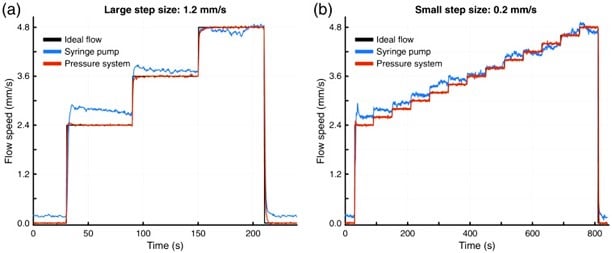
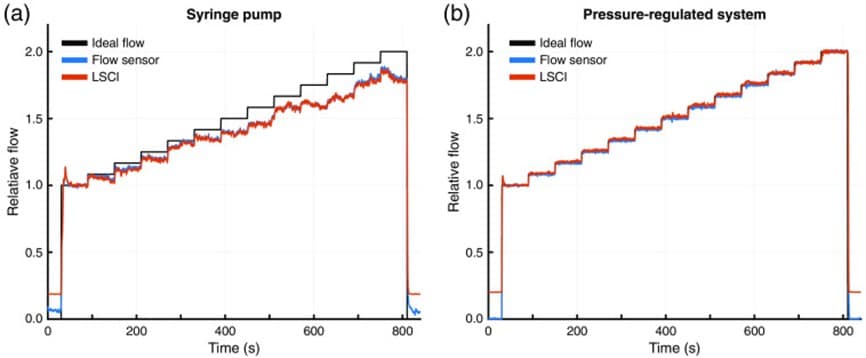
| Expanded Uncertainty (for repeatability and reproducibility) (%) | |||
| Flow speed (mm/s) | 2.4 | 3.6 | 4.8 |
| Syringe pump | 22.2 | 5.89 | 6.68 |
| Pressure-driven controller (MFCS-EZ) | 1.11 | 0.91 | 0.77 |
The expanded uncertainty, calculated through the standard uncertainties of flow repeatability and flow reproducibility, confirmed the limitations of the syringe pump, especially for small flow speed variations (Table 1). For instance, it would be impossible to reliably separate 22% of changes in relative flow from flow system noise at the 2.4 mm∕s flow speed due to its uncertainty. This high percentage of uncertainty in flow generation would make it difficult to evaluate an optical system’s ability to detect small changes in flow, which is critical in blood visualization by LSCI. This limitation could be unlocked by using pressure-driven controllers, where only 1.11% of uncertainty is measured at 2.4 mm/s (compared to 22% for syringe pumps), and therefore any changes in the optical system measurement would not be caused by a flow system noise. This difference in uncertainty between syringe pumps and pressure-driven controllers was also marked for higher flow rates (Table 1).
Conclusion
In this paper highlight, Collin Sullender et al., from the Functional Optical Imaging Laboratory (University of Texas at Austin), succeeded in quantifying the uncertainty in the flow produced by a syringe pump and our pressure-driven flow controller. Using our MFCS-EZ controller, a stable and repeatable flow was generated compared to the syringe pump. Based on the obtained results, switching from syringe pump systems to our pressure-driven controllers is a key parameter to eliminating flow-related errors and producing more reliable measuring and imaging flow techniques. This approach unlocks new opportunities in terms of accurately evaluating and comparing imaging techniques (as also proved in this paper by comparing Laser LSCI and multi-exposure speckle imaging (MESI)).2,3
Alos, learn about the efficiency of our LineUp and MFCS-EZ pressure-drive controllers for droplet generation when compared to syringe pumps.
Related products
Related Resources
-
Microfluidics Case Studies Micropipette Aspiration of Red Blood Cells Mechanosensitivity and Mechanics Read more
-
Expert Reviews: Basics of Microfluidics Optimizing Microfluidic Perfusion: Best Practices and Innovations Read more
-
Expert Reviews: Basics of Microfluidics Pressure-Controlled Microfluidics in Organ-On-A-Chip Research Read more
-
Microfluidic Application Notes Peristaltic Pump vs Pressure-Based Microfluidic Flow Control for Organ on Chip applications Read more
-
Expert Reviews: Basics of Microfluidics The Importance of Flow Control Stability in Microfluidics Read more
-
Expert Reviews: Basics of Microfluidics Flow control for droplet generation using syringe pumps and pressure-based flow controllers Read more
-
Expert Reviews: Basics of Microfluidics Pump Responsiveness in microfluidics Read more
-
Expert Reviews: Basics of Microfluidics Flow Control Technologies: Comparison between peristaltic, syringe and pressure pumps for microfluidic applications Read more
References
The full article:Paper: Sullender, Colin T., Adam Santorelli, Lisa M. Richards, Pawan K. Mannava, Christopher Smith, et Andrew K. Dunn. « Using Pressure-Driven Flow Systems to Evaluate Laser Speckle Contrast Imaging ». Journal of Biomedical Optics 28, no 03 (11 mars 2023). https://doi.org/10.1117/1.JBO.28.3.036003
- (1) Kazmi, S. S.; Richards, L. M.; Schrandt, C. J.; Davis, M. A.; Dunn, A. K. Expanding Applications, Accuracy, and Interpretation of Laser Speckle Contrast Imaging of Cerebral Blood Flow. J Cereb Blood Flow Metab 2015, 35 (7), 1076–1084. https://doi.org/10.1038/jcbfm.2015.84.
- (2) Sullender, C. T.; Santorelli, A.; Richards, L. M.; Mannava, P. K.; Smith, C.; Dunn, A. K. Using Pressure-Driven Flow Systems to Evaluate Laser Speckle Contrast Imaging. J. Biomed. Opt. 2023, 28 (03). https://doi.org/10.1117/1.JBO.28.3.036003.
- (3) Parthasarathy, A. B.; Tom, W. J.; Gopal, A.; Zhang, X.; Dunn, A. K. Robust Flow Measurement with Multi-Exposure Speckle Imaging. Opt. Express2008, 16 (3), 1975. https://doi.org/10.1364/OE.16.001975.
